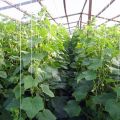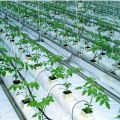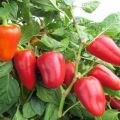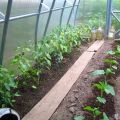How often and when to water pepper in the open field and in the greenhouse
Nowadays, gardeners can grow a wide variety of different vegetables. Many of them cultivate peppers in the greenhouse and in the open field. This vegetable is a good addition to many different dishes and, for this reason, it is popular among vegetable growers. During cultivation, this plant should be properly looked after. Therefore, it is recommended that you familiarize yourself in advance with how often to water peppers in the greenhouse and outdoors.
Optimal conditions for peppers
Before you know how to properly water a pepper in a greenhouse, you need to familiarize yourself with the most suitable conditions for growing it. It is no secret that sweet peppers are very fond of heat and therefore a good harvest can be obtained only if they are planted in a greenhouse or in the soil of the southern regions.
The main recommendations for arranging an ideal place for peppers include:
- Bushes should not shade each other. Therefore, it is recommended to plant them at a distance of at least 30 cm.The gap between each row should be 75-90 cm.
- When the seedlings grow 20 cm, they will have to be tied to wooden or metal supports. They can break due to the weight of the fruit if this is not done.
- It is necessary to plant bushes only in well-lit areas or rooms. With an insufficient amount of light, the yield can drop several times.
- To have more fruit after planting, pepper is grown only in warm soil, the highest temperature of which should not be higher than 20 degrees.
- The soil on the site should not be crusty. It is recommended to loosen the soil once a week.

Watering frequency
After reading the basic tips for arranging a place for growing seedlings, you should find out how often you need to water the bell pepper after planting in the ground. This issue is very important, since the frequency of soil moisture affects the quantity and quality of the crop.
Inexperienced growers water the pepper too often. It is not recommended to do this, since due to high humidity, the chance of deterioration in yield is extremely high. To understand how many times it is better to water peppers in a polycarbonate greenhouse or open field, you should familiarize yourself with the main factors on which this depends. These include the following:
- air humidity level;
- the duration of the growing season;
- soil type;
- air temperature;
- plant variety.
The vegetable does not develop very quickly in too dry soils, so watering the pepper in the open field should be done regularly. At the initial stages of development, the soil is moistened once every 5-8 days. After the opening of the first flower, the procedure should be carried out a little more often. It is recommended that you do this twice a week.
Not everyone knows how often to water the plant in summer. On summer days, it is watered most often, since the soil dries out very quickly due to the high temperature. In this case, the procedure is carried out daily in the evening and in the morning.
It is not recommended to moisten the soil on a sunny day, as this can negatively affect the roots of the plant.
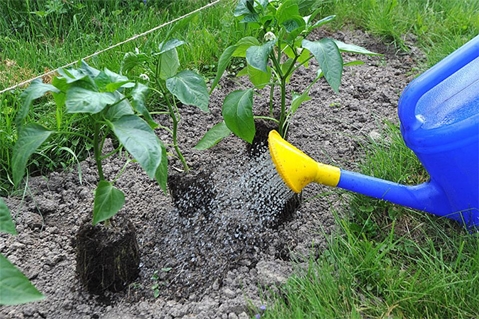
Water used
Having figured out how often you need to water the peppers in the open field, you should figure out the water used. After all, when irrigating, you should use the most suitable liquid. The quality of the grown fruits will largely depend on it.
It is recommended to fill the bushes with only heated water, especially for residents of the northern regions, where the temperature is rather low. In this case, you can moisten the soil not only with liquid from the tap, but also with rainwater collected in advance. To prepare the liquid, add water to a large bucket and boil it over. Then let it cool down for a few hours and water the plants with it.
Residents of the southern regions do not need to heat a container with water on the stove.
Instead, it can be warmed up under the sun during the day. In one day, it can warm up to a temperature that is ideal for peppers.
Basic methods
To understand how to water peppers in a greenhouse, you need to familiarize yourself with the basic methods of soil moisture. There are several basic methods that are used quite often when growing pepper fruits.
Manual
This method is the most common, but also very time consuming. First you need to decide when it is best to use the manual method. It is most often used if the site does not have a special system for watering pepper in a polycarbonate greenhouse.
In this case, the soil is moistened using special watering cans or any other containers. It is recommended that you do manual watering only in the morning before the sun has risen. However, in the case of greenhouse cultivation, you can water the fruit at any time.
The basic rules for using the manual method include:
- for each plant, no more than two liters of liquid must be spent;
- when watering bushes in a greenhouse, the amount of water consumed can be reduced by a quarter;
- if the peppers are planted in soil with a small amount of minerals, then the volume of the liquid used increases by 2-4 liters;
- before moistening the site, it is necessary to loosen the soil so that the liquid is evenly distributed;
- during the appearance of the first ovaries, the bushes should be manually watered no more than twice every 10 days.
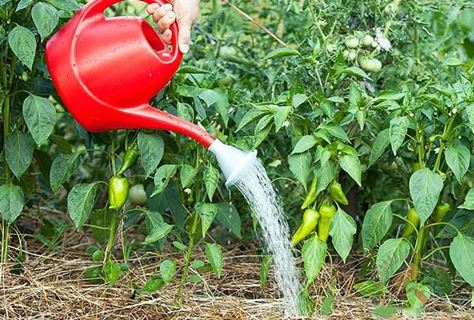
Auto
If you don't want to use the manual method, you will have to familiarize yourself with how to water peppers in a greenhouse in an automatic way. In this case, you will have to use nozzles and high-quality pipes. In addition, special equipment is used, with the help of which the frequency of watering will be regulated.
There are several types of automatic irrigation and one of them is the drip method. This system is more suitable for people who do not want to waste too much fluid. If there is no need to save water, then you can use sprinkling.
The main advantage of this method can be considered that when it is used, a hard crust does not form on the surface of the earth.
During the organization of automatic watering, you will have to deal with the installation of pipes. They can be laid anywhere, even underground. For such purposes, it is better to buy pipes made of durable plastic, since products made of softer material can burst under the pressure of a powerful water pressure.
After laying the pipes, special holes are made in them through which the liquid will seep into the ground. At the same time, such holes need to be made in certain places. In this case, everything depends on the soil in which the pepper is grown. If it is too light, then holes will be made every 10-25 cm. For earth with medium density, they are made less often - at a distance of 30 cm from each other. If the plant is grown in loamy soil, then the pipes are pierced every 40-50 cm.
It should be noted that this method is not suitable for all types of pepper. Therefore, you should ask the seller in advance whether it is possible to water the purchased variety in this way.
Mechanical
This method is simpler than the others. To use it, you will need to install a special structure that will ensure a continuous flow of water into the system for irrigating the bushes. This design includes pipes and a pump for pumping out liquid. The advantages of the mechanical method include the fact that its use is much cheaper than the automatic one.

Since the design for irrigation is directly dependent on electricity, you will have to take care of the safety net in advance. It is recommended to install an additional reservoir of irrigation liquid. This water will be used if the electricity is suddenly cut off. It is also possible to connect the system not to the reservoir, but to the well. It is even better to use a well, since water will not run out quickly in it.
Conclusion
To get a good harvest of peppers, they must be properly cared for. Irrigation is the main component of caring for any vegetable and therefore it is necessary to know in advance how often you need to water the pepper in the open field. Also, you can learn a lot about watering with the help of feedback from people who have already planted peppers and know everything about caring for them.



